Member
Joined 2008
Hello everyone,
Let's assume that we want to use 2 woofers per speaker in acoustic suspension design (closed box).
Each of them needs 20lts for an optimal 0.7 Q, and both woofers have exactly the same characteristics (same woofers).
->Would you prefer to use 2 separate closed cabinets of 20 lts each or mount both of them in one closed box with total internal volume of 40lts?
Thanks for your time.
ps. Our only consideration is the best sound quality, not total cabinet cost/size etc.
Let's assume that we want to use 2 woofers per speaker in acoustic suspension design (closed box).
Each of them needs 20lts for an optimal 0.7 Q, and both woofers have exactly the same characteristics (same woofers).
->Would you prefer to use 2 separate closed cabinets of 20 lts each or mount both of them in one closed box with total internal volume of 40lts?
Thanks for your time.
ps. Our only consideration is the best sound quality, not total cabinet cost/size etc.
Last edited:
Fundamentally, there is no difference. Modally, when you mount them symmetrically or when the cabinet is sufficiently stuffed, there is no difference either.
Fundamentally, there is no difference. Modally, when you mount them symmetrically or when the cabinet is sufficiently stuffed, there is no difference either.
😕
If the drivers are exactly the same and mounted symmetrically, it should not make a difference,
but the drivers won't be exactly the same, so they will interact.
but the drivers won't be exactly the same, so they will interact.
Last edited:
I'd like to be helpful but I'm a little uncertain too. Do you disagree or did I not explain myself very well?
Member
Joined 2008
If you are using good drivers the QC should be good and they match well. Therefore they should work fine in a common volume.
If you were mixing brands/ models/ sizes then definitely separate enclosures.
If you were mixing brands/ models/ sizes then definitely separate enclosures.
Years ago, I built a sub with 4 12" woofers, one on each side of the cabinet. All shared the same volume. Sounded amazing.
2 Boxes are easier to transport and give more placement options; more options to get a smoother bass response in the room. (nice for subwoofers)
If drivers share a box/volume; don't wire them in series, only parallel as otherwise the little differences between the drivers are amplified/magnified. (2 drivers are never 100% identical)
If drivers share a box/volume; don't wire them in series, only parallel as otherwise the little differences between the drivers are amplified/magnified. (2 drivers are never 100% identical)
Member
Joined 2008
There's a few wrong assumptions here. Acoustic Suspension is NOT the same thing as closed box. 😀
THIS is Acoustic Suspension:
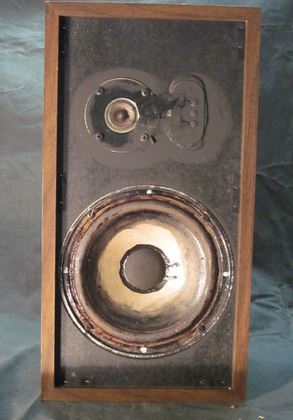
An AR4 loudspeaker. Designed by Edgar Villchur, Roy Allison and Henry Kloss about 50 years ago:
A Glorious Time: AR's Edgar Villchur and Roy Allison Allison Part 1 | Stereophile.com
Edgar Villchur managed to build big bass into small boxes and ended up with about 50% of market share for a decade.
A good idea can always be improved. The Gale 401 was based on two Acoustic suspension drivers, parallel wired in a common enclosure, which makes for great bass and drums:
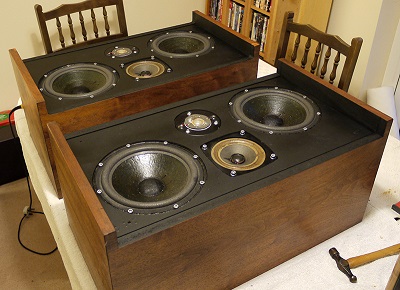
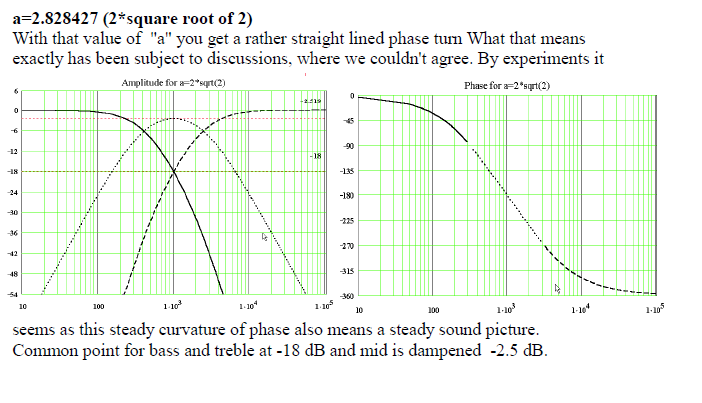
I really don't know if parallel wiring or series wiring is better in a common enclosure. Time will tell. For sure, parallel wiring can lead to difficult low impedance for amplifiers. The Gale was notorious for destroying amplifiers! 😱
What is different about acoustic suspension from closed box, is the bass units have huge magnets and low Qts near 0.38, and heavy cones with low Fs and rely on the air-spring for the restoring force. Closed box uses small magnet drivers with a Qts near 0.5. In fact, Qts 0.5 drivers are hard to find these days. Most modern speakers are reflex.
THIS is Acoustic Suspension:
An AR4 loudspeaker. Designed by Edgar Villchur, Roy Allison and Henry Kloss about 50 years ago:
A Glorious Time: AR's Edgar Villchur and Roy Allison Allison Part 1 | Stereophile.com
Edgar Villchur managed to build big bass into small boxes and ended up with about 50% of market share for a decade.
A good idea can always be improved. The Gale 401 was based on two Acoustic suspension drivers, parallel wired in a common enclosure, which makes for great bass and drums:
I really don't know if parallel wiring or series wiring is better in a common enclosure. Time will tell. For sure, parallel wiring can lead to difficult low impedance for amplifiers. The Gale was notorious for destroying amplifiers! 😱
What is different about acoustic suspension from closed box, is the bass units have huge magnets and low Qts near 0.38, and heavy cones with low Fs and rely on the air-spring for the restoring force. Closed box uses small magnet drivers with a Qts near 0.5. In fact, Qts 0.5 drivers are hard to find these days. Most modern speakers are reflex.
What is the config - 2 or 3-way?
Internal standing waves might be a problem with a 2-way and large common enclosure (playing up to 2-3kHz).
You can study this with some room mode simulators that work also with small dimensions.
To play safe, 2-way should have separate boxes, which might have a minimal pressure release aperiodic vent in-between, if you want.
If bass-tuning is intended with bass-reflex or transmission line, all this gets much trickier! Too tricky for me actually...
Internal standing waves might be a problem with a 2-way and large common enclosure (playing up to 2-3kHz).
You can study this with some room mode simulators that work also with small dimensions.
To play safe, 2-way should have separate boxes, which might have a minimal pressure release aperiodic vent in-between, if you want.
If bass-tuning is intended with bass-reflex or transmission line, all this gets much trickier! Too tricky for me actually...
Member
Joined 2008
What is the config - 2 or 3-way?
Internal standing waves might be a problem with a 2-way and large common enclosure (playing up to 2-3kHz).
You can study this with some room mode simulators that work also with small dimensions.
To play safe, 2-way should have separate boxes, which might have a minimal pressure release aperiodic vent in-between, if you want.
If bass-tuning is intended with bass-reflex or transmission line, all this gets much trickier! Too tricky for me actually...
Hello, large multiway, the woofers will play frequencies from about 20Hz to 120Hz.
Thanks for sharing your thoughts about 2 way speakers and possible cabinet issues around 1-3kHz.
@Steve, IIRC Vance Dickason differentiated acoustic suspension from infinite baffle. He drew the line at Vas/3.
This has been nagging me. Series or parallel wiring in a common enclosure.
Thought I'd figured out that series wiring was best, especially with high output impedance amps:
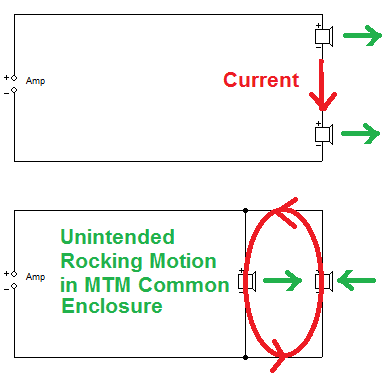
Now, I'm not too sure!
This is an Allison 1 or 2:
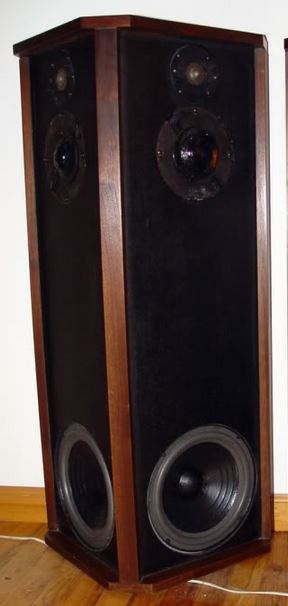
Seems you can wire it either way:

stereonomono - Hi Fi Compendium: Allison model ONE
Maybe we worry too much! In the vaguely related isobaric speaker, Jeff Bagby ( who knows a lot!) thinks series or parallel is just a design choice:
Isobaric subwoofer design, many questions! -
Techtalk Speaker Building, Audio, Video Discussion Forum
But it's a worry to someone as OCD as me. This is actually the same problem as a car differential in engineering terms: Differential (mechanical device) - Wikipedia
FWIW, in PA systems, separate enclosures are preferred. If one woofer blows, the other one stays acoustically loaded, so will survive.
Thought I'd figured out that series wiring was best, especially with high output impedance amps:
Now, I'm not too sure!
This is an Allison 1 or 2:
Seems you can wire it either way:
stereonomono - Hi Fi Compendium: Allison model ONE
Maybe we worry too much! In the vaguely related isobaric speaker, Jeff Bagby ( who knows a lot!) thinks series or parallel is just a design choice:
Isobaric subwoofer design, many questions! -
Techtalk Speaker Building, Audio, Video Discussion Forum
But it's a worry to someone as OCD as me. This is actually the same problem as a car differential in engineering terms: Differential (mechanical device) - Wikipedia
FWIW, in PA systems, separate enclosures are preferred. If one woofer blows, the other one stays acoustically loaded, so will survive.
Last edited:
Member
Joined 2008
I think that xover simulation software makes the choice of wiring parallel/in series easier. It depends on the actual drivers, the crossover point and the impendance values/phase etc of every speaker.
I think that xover simulation software makes the choice of wiring parallel/in series easier. It depends on the actual drivers, the crossover point and the impedance values/phase etc of every speaker.
I'd guess most Simulators assume separate enclosures for the two woofers. So no help there! 😀
Member
Joined 2008
We've seen enough parallel-wired MTMs to not to even go into it....
Series-wired in common enclosure is doable too as in Joe Rasmussen's splendid Elsionore:
Elsinore Speakers DIY
I really don't know! 😕
Series-wired in common enclosure is doable too as in Joe Rasmussen's splendid Elsionore:
Elsinore Speakers DIY
I really don't know! 😕
- Home
- Loudspeakers
- Multi-Way
- Acoustic suspension(sealed box) using 2 woofers